<< Previous | Displaying results 4051-4075 of 6771 for "" | Next >>
Two of Julien Bryan's Nazi Germany 1937 contact print booklets of still photographs organized by camera roll. Bryan used these prints to select and crop images for publication or distribution and annotated the covers.

Many of Julien Bryan's original 35mm nitrate film rolls were actively deteriorating when the United States Holocaust Memorial Museum acquired the collection in 2003.
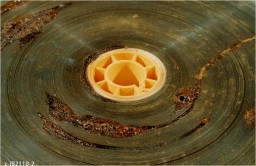
One of the primary documents used to calculate the number of deaths in the Nazi "euthanasia" program is this register discovered in a locked filing cabinet by US Army troops in 1945 at a killing site in Hartheim, Austria. The right page details by month the number of patients who were "disinfected" in 1940. The final column indicates that 35,224 persons had been put to death that year.

A red and yellow floral handkerchief belonging to Judit Gondos that she took with her when she left Budapest on the Kasztner rescue train.

Violin owned by Rita Prigmore and originally used by her father, who played with his four brothers in a band in Germany before World War II. Rita and her family were members of the Sinti group of Roma (Gypsies). She and her twin sister Rolanda were born in 1943. Rolanda died as a result of medical experiments on twins in the clinic where they were born. Rita and her mother survived the war and moved to the United States, before returning to Germany to run a Sinti human rights organization that sought to…
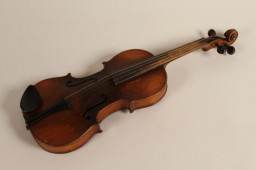
This small patterned hooked rug was used as a shoe mat in the wagon of Rita Prigmore and her family when she was a child in Wurzberg, Germany, after World War II. Rita and her family were members of the Sinti group of Roma (Gypsies). She and her twin sister Rolanda were born in 1943. Rolanda died as a result of medical experiments on twins in the clinic where they were born. Rita was returned to her family in 1944. She and her mother survived the war and moved to the United States, before returning to…
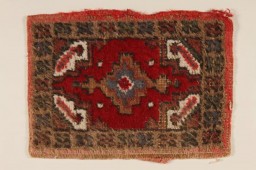
These blacksmith's bellows were used by Romani (Gypsy) artisan Juri Cervenuak in Trebisov, Slovakia, in 1939. Many Roma traditionally worked as craftsmen and were blacksmiths, cobblers, tinsmiths, horse dealers, and toolmakers.
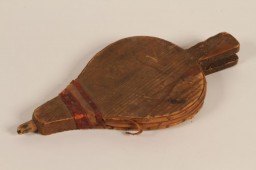
This Olympic torch holder was used during the 1936 Berlin Olympics. It is engraved with the 1936 Olympics torch relay route from Olympia, Greece, to Berlin, Germany.
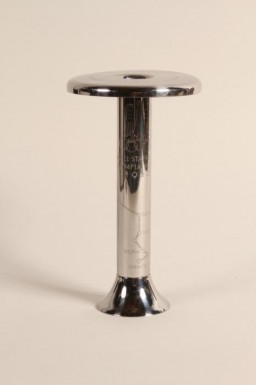
In 1963, the German Democratic Republic (DDR) issued this postage stamp to commemorate the Treblinka killing center. This was the first stamp of a series issued annually by the DDR under the name Mahn- und Gedensksatte (Remembrance and Memorial Center) in remembrance and commemoration.
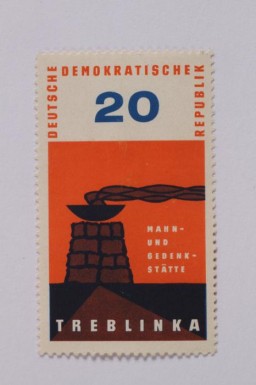
In December 1939, German authorities required Jews residing in the Generalgouvernement (which included Krakow) to wear white armbands with blue Stars of David for purposes of identification. The armband pictured here was donated to the United States Holocaust Memorial Museum in 2001 by Akiva Kohane.
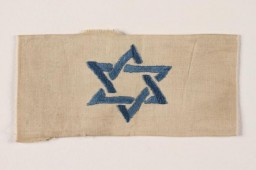
Nazi banner with a swastika. The swastika became the most recognizable symbol of Nazi propaganda, appearing on the Nazi flag, election posters, arm bands, medallions, and badges for military and other organizations.
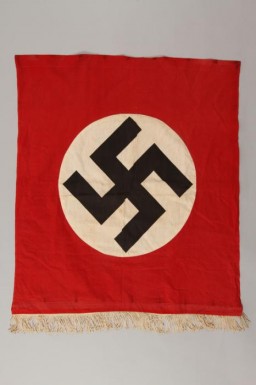
Jewish teenager Ava Hegedish drew this poignant picture of her mother's well-worn shoes while in hiding. It was drawn while Ava was in hiding at a farm near Belgrade, Yugoslavia (now Serbia), between 1941 and 1944. Once Nazi Germany and its Axis partners partitioned Yugoslavia and Belgrade fell under German control, Ava’s father thought the family’s best chance of survival was to separate and go into hiding. Ava ended up at a farm with some extended-family Serbian relatives. Because she…
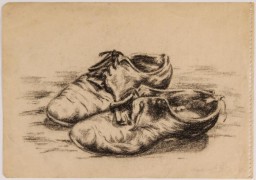
This paper tag identified bedding belonging to Alice (Lisl) Winternitz when she was deported from Prague, Czechoslovakia, to the Theresienstadt ghetto in June 1942.
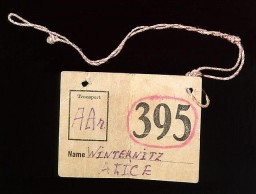
White armband with a Star of David embroidered in blue thread, worn by Dina Offman from 1939 until 1941 while in the ghetto in Stopnica, Poland.
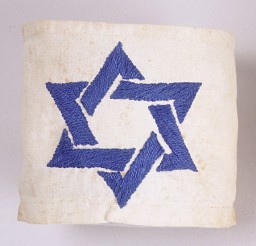
White armband with a Star of David embroidered in blue thread, worn by Dina Offman from 1939 until 1941 while in the ghetto in Stopnica, Poland.
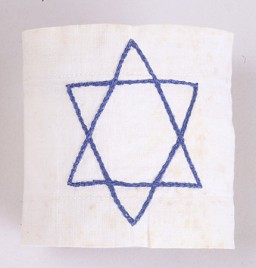
Zofia Burowska (Chorowicz) donated this doll, which dates from the 1930s, to the United States Holocaust Memorial Museum. Zofia's parents gave her the doll before the war and she kept it with her in the Wolbrum and Krakow ghettos, Poland. The doll and some of her family's other belongings were left with non-Jewish friends for safekeeping. Zofia was deported to a forced-labor camp for Jews near Krakow, to the Skarzysko-Kamienna camp (also in Poland), and then to the Buchenwald concentration camp in Germany,…
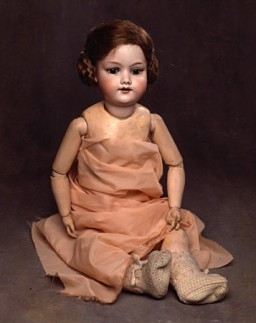
Leon Jakubowicz, a shoemaker by training and a native of Lodz, began constructing this model of the Lodz ghetto soon after his arrival there from a prisoner-of-war camp in April 1940. The case holds a scale (1:5000) model of the ghetto, including streets, painted houses, bridges, churches, synagogue ruins, factories, cemeteries, and barbed wire around the ghetto edges. The model pieces are made from scrap wood. The case cover interior is lined with a collection of official seals, a ration card, and paper…

SS Major General Juergen Stroop, commander of German forces that suppressed the Warsaw ghetto uprising, compiled an album of photographs and other materials. This album, later known as "The Stroop Report," was introduced as evidence at the International Military Tribunal at Nuremberg. Here, its cover is marked with an IMT evidence stamp.
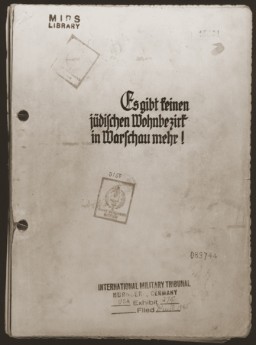
This tan backpack was used by Ruth Berkowitz to carry her belongings as she fled from Warsaw via Lithuania and the Soviet Union to Japan. Most of her possessions were confiscated by both the Nazis and the Soviets during her journey. [From the USHMM special exhibition Flight and Rescue.]
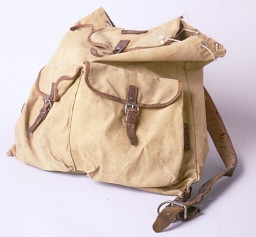
Leon Jakubowicz, a shoemaker by training and a native of Lodz, began constructing this model of the Lodz ghetto soon after his arrival there from a prisoner-of-war camp in April 1940. The case holds a scale (1:5000) model of the ghetto, including streets, painted houses, bridges, churches, synagogue ruins, factories, cemeteries, and barbed wire around the ghetto edges. The model pieces are made from scrap wood. The case cover interior is lined with a collection of official seals, a ration card, and paper…
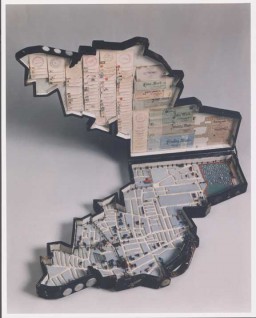
Survivors of the camps lacked even basic possessions, such as footwear. The Red Cross issued these United States Army boots to Jacob Polak in June or July 1945 after his repatriation to the Netherlands.
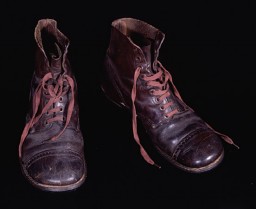
A pair of candlesticks, bought in Poland and used every Friday evening during observance of the Jewish Sabbath. Polish Jewish refugees fleeing the German invasion of Poland in 1939 carried these candlesticks with them to Vilna.
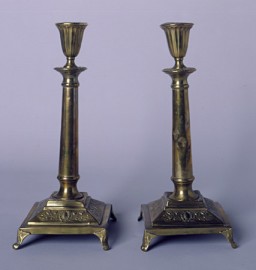
A suitcase used (ca. 1939) by a Jewish refugee fleeing Nazi-occupied Europe to Japan. The suitcase is covered with labels from various stops along the journey, including one from a hotel in Moscow (top left), one for the NYK Line (top middle), and six from hotels throughout Japan. [From the USHMM special exhibition Flight and Rescue.]
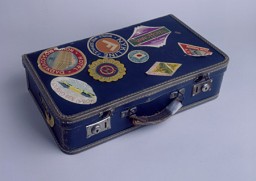
During the 1943 liquidation of the Lvov ghetto, dozens of Jews fled into the city sewers to escape death. Eight-year-old Krystyna Chiger (later Kristine Keren) hid with her family and 16 others beneath the city's streets for 14 months, during which she wore this sweater.
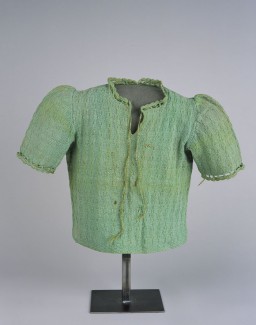
A blue and white child's dress worn by Sabina Kagan while living in hiding with the Roztropowicz family in Radziwillow, Poland, during World War II. Her rescuers used doll's clothing to make this dress. Sabina was just an infant when SS mobile killing squads began rounding up Jews in the Polish village of Radziwillow in 1942. Her parents persuaded a local policeman to hide the family. The policeman, however, soon asked the Kagans to leave but agreed to hide baby Sabina. Her parents were captured and…
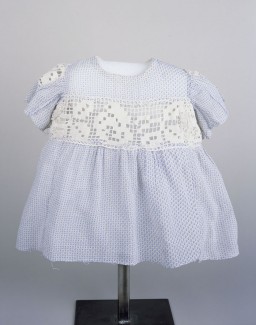
We would like to thank Crown Family Philanthropies, Abe and Ida Cooper Foundation, the Claims Conference, EVZ, and BMF for supporting the ongoing work to create content and resources for the Holocaust Encyclopedia. View the list of donor acknowledgement.